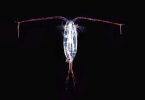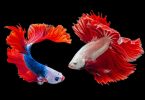Table of Contents
Have you ever wondered if angelfish and goldfish can coexist in the same aquarium? While both are popular fish species, they have different temperaments and requirements that may make it challenging for them to live together.
In this article, we’ll explore the compatibility of angelfish and goldfish, discussing the factors that affect their ability to coexist, such as water temperature, tank size, and feeding habits.
We’ll also provide tips on how to set up a tank that accommodates both species and discuss alternative tankmates for angelfish and goldfish.
Whether you’re a seasoned aquarist or a beginner, read on to discover everything you need to know about keeping angelfish and goldfish together.
Compatibility
If you’re considering keeping angelfish and goldfish together, it’s important to understand their compatibility.
In this section, we’ll explore whether angelfish can live with goldfish, factors to consider, and the benefits of keeping them together.
Can Angelfish Live with Goldfish?
Angelfish and goldfish have different care requirements and temperaments, which can make it challenging to keep them together.
Angelfish are tropical fish that prefer warm water temperatures, while goldfish are coldwater fish that thrive in cooler temperatures.
Additionally, angelfish are known for being territorial and aggressive, while goldfish are peaceful and social.
While it’s possible for angelfish and goldfish to coexist in the same tank, it’s generally not recommended. If you do decide to keep them together, you’ll need to take extra care to ensure that their needs are met and that they don’t harm each other.
Factors to Consider
Before deciding to keep angelfish and goldfish together, there are several factors to consider. These include:
- Tank size: Both angelfish and goldfish require ample space to swim and thrive. You’ll need a large enough tank to accommodate both species, as well as any other fish you plan to keep.
- Water temperature: Angelfish prefer warmer water temperatures between 78-82°F, while goldfish thrive in cooler temperatures between 65-75°F. It can be challenging to maintain a consistent temperature that meets the needs of both species.
- Water quality: Both angelfish and goldfish require clean, well-oxygenated water to thrive. You’ll need to monitor water quality regularly and perform frequent water changes to maintain optimal conditions.
- Diet: Angelfish and goldfish have different dietary requirements. Angelfish are omnivores and require a varied diet that includes both plant and animal matter, while goldfish are primarily herbivores and require a diet that’s high in plant matter.
Benefits of Keeping Angelfish and Goldfish Together
While there are challenges to keeping angelfish and goldfish together, there are also some potential benefits. For example:
- Variety: Keeping angelfish and goldfish together can add variety to your tank and create a visually interesting environment.
- Compatibility: While angelfish and goldfish have different temperaments, they can coexist peacefully if the tank is set up correctly and their needs are met.
- Reduced aggression: Keeping multiple fish species in a tank can help reduce aggression among individual fish by providing a more complex social environment.
Overall, while it’s possible to keep angelfish and goldfish together, it’s important to carefully consider their compatibility and needs before doing so.
With proper care and attention, however, they can coexist peacefully and create a visually interesting and diverse tank.
Habitat Requirements
When considering keeping angelfish and goldfish together, it is important to understand their habitat requirements. This includes water temperature, water quality, and tank size.
Water Temperature
Angelfish are tropical fish and require warmer water temperatures than goldfish. The optimal water temperature for angelfish is between 75-82°F, while goldfish prefer cooler water temperatures between 65-72°F. It is important to maintain a consistent water temperature to avoid stressing the fish. You can use a heater to maintain the water temperature for angelfish, but it is not recommended for goldfish.
Water Quality
Both angelfish and goldfish require clean water to thrive. However, angelfish are more sensitive to changes in water quality than goldfish. Angelfish require a pH level between 6.5-7.5 and soft to moderately hard water.
Goldfish can tolerate a wider range of pH levels and harder water. It is important to maintain good water quality by performing regular water changes and testing the water parameters.
Tank Size
Angelfish and goldfish have different tank size requirements. Angelfish require a minimum tank size of 20 gallons, while goldfish require a minimum of 30 gallons for a single fish and an additional 10 gallons for each additional fish.
It is important to provide enough space for each fish to swim and establish their territory. Overcrowding can lead to stress, aggression, and poor water quality.
In summary, angelfish and goldfish have different habitat requirements, including water temperature, water quality, and tank size.
It is possible to keep them together, but it requires careful consideration and monitoring of their environment. Providing the right conditions can help ensure the health and well-being of both species.
Feeding
When it comes to feeding, angelfish and goldfish have different dietary needs. Here are some things to keep in mind:
Dietary Needs of Angelfish
Angelfish are omnivores, which means they eat both plant and animal matter. They require a diet that is rich in protein and vitamins.
In the wild, they eat insects, small crustaceans, and other small aquatic creatures. In captivity, you can feed them a variety of foods, including:
- Pellets or flakes designed for angelfish
- Frozen or live brine shrimp
- Bloodworms
- Daphnia
- Other small aquatic creatures
It’s important to note that angelfish are prone to constipation, so be careful not to overfeed them. You should also avoid feeding them food that is too high in fat or protein.
Dietary Needs of Goldfish
Goldfish are omnivores as well, but they have a slightly different diet than angelfish. They require a diet that is high in carbohydrates and fiber.
In the wild, they eat algae, plants, and small aquatic creatures. In captivity, you can feed them a variety of foods, including:
- Pellets or flakes designed for goldfish
- Vegetables, such as spinach, peas, and lettuce
- Bloodworms
- Daphnia
- Other small aquatic creatures
It’s important to note that goldfish are prone to overeating and obesity, so be careful not to overfeed them. You should also avoid feeding them food that is too high in protein.
Feeding Frequency
Both angelfish and goldfish should be fed two to three times a day, but in smaller quantities. Overfeeding can lead to health problems, such as constipation, obesity, and poor water quality. It’s important to monitor your fish’s eating habits and adjust their feeding schedule accordingly.
In summary, angelfish and goldfish have different dietary needs, so it’s important to feed them the right foods in the right quantities. By doing so, you can ensure that your fish stay healthy and happy.
Behavior
When considering whether angelfish can live with goldfish, it’s important to take into account their behavior. Here are some factors to consider:
Social Interaction
Angelfish are generally social creatures and enjoy the company of other fish. They may form pairs or small groups and will often swim together.
Goldfish, on the other hand, are not typically social and prefer to be alone. They may become stressed or agitated if kept with other fish.
Aggression
Angelfish can be territorial and may become aggressive towards other fish, especially if they feel their space is being invaded.
They may nip at the fins of other fish or even attack them. Goldfish, on the other hand, are generally peaceful and do not exhibit aggressive behavior.
Compatibility with Other Fish
Angelfish are compatible with a variety of other fish, but it’s important to choose fish that have similar temperaments and water requirements.
Goldfish have different water requirements than angelfish and may not be compatible in the same tank. Additionally, goldfish are known to produce a lot of waste, which can create poor water conditions for other fish.
In summary, while angelfish can live with goldfish, it’s important to consider their behavior and compatibility with other fish. Angelfish may be social and territorial, while goldfish are generally solitary and peaceful.
It’s important to choose fish that have similar water requirements and temperaments to ensure a harmonious tank environment.
Conclusion
In conclusion, while it is possible for angelfish and goldfish to coexist in the same aquarium, it is not recommended.
The two species have different requirements when it comes to water temperature, pH levels, and water flow. Goldfish prefer cooler water temperatures between 65-72°F, while angelfish prefer warmer water temperatures between 75-82°F. This temperature difference can cause stress and health problems for both species.
Additionally, goldfish produce a lot of waste, which can lead to poor water quality. Angelfish are more sensitive to poor water quality and require a higher level of filtration and water flow.
The two species also have different feeding requirements, with goldfish being primarily herbivores and angelfish being omnivores.
If you do decide to keep angelfish and goldfish together, it is important to monitor the water quality closely and ensure that the aquarium is large enough to accommodate both species comfortably. A larger aquarium will also help to reduce aggression between the two species.
Overall, it is recommended to keep angelfish and goldfish in separate aquariums to ensure the health and well-being of both species.







